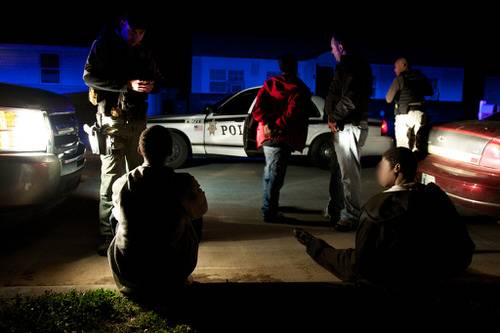
Last year, Chicago witnessed more than 500 murders, more than both New York City and Los Angeles. While that number is declining—this year so far, the city’s murder rate is down 22 percent—much of the ongoing violence is related to gang activity, with some 630 different factions frequently battling it out across the city.
To combat gang killings, the Chicago Police Department is going door to door letting gang members know the likelihood of their demise.
According to Governing magazine, the Chicago Police Department is using a social-media based “network analysis” that maps the relationships among the 14,000 most active gang members in the city. The results show how likely they are to kill or be killed as a result of gang violence. As the magazine put it:
The CPD has discovered something striking: Cities don’t so much have “hot spots” as “hot people.”
The network analysis determined that people in the gang networks are three or four hundred times more likely to be a victim of murder than the average citizen, Deputy Chief Robert Tracy told Governing.
The police department worked with a local sociologist to develop the social mapping strategy, that documents and predicts behaviors similar to how platforms like Facebook and Twitter track our relationships and conversations. The network analysis is like a real-life version of Facebook’s Graph Search, the social search tool that analyzes likes, connections and conversations to produce user-specific search results:
[T]he department built a model to help it identify Chicago’s “hottest” residents—that is, the likeliest to be involved in violence. The model includes such variables as how many times a person had been shot, how many times a person had been contact-carded, whether he had any gun convictions and whether he was on probation or parole. By the spring, they had identified a top 20 list for each of the city’s 22 police districts.
The police department and an organization called Chicago Violence Reduction Strategy then teamed up to knock on doors with a one-two punch of a message. Police tell these identified “habitual offenders” and known gang members that they could face heavy federal—not state—charges for any future offenses, news that comes as a surprise to some. But the teams also warn their targets that they’re at risk of murder themselves, and that their families and communities want them alive.
Sometimes it works. Sometimes it doesn’t. But Chicago authorities believe their outreach may be helping reduce the murder rate.
Yet what social analysis giveth, social media can taketh away. Because while the CPD and dedicated organizations work social networks to lower the murder rate, top gang members are using Facebook and Twitter to taunt one another—and to brag about the resulting violence.
Fighting Crime Online
Last year, violence in the streets spilled over into a Twitter war. Two main Chicago gang factions, the Black Disciples (#BDK) and the Gangster Disciples (#GDK), emerged as trending topics on Twitter after an online dispute led to the shooting of 18-year-old JoJo, a Gangster Disciples member.
According to Wired, the teen’s murder led to a number of retaliation killings and outcry on social media, including YouTube and Facebook. There’s even a term for gang members who cause trouble on social media. They’re called “Facebook drillers,” a play on “drilling” someone—i.e., shooting them.
In the Bay Area, home to some of the top social networks, the San Francisco Police Department finds social media tools can be helpful in capturing and targeting criminals.
“We have used social media—Facebook and Twitter—to capture criminals by obtaining tips or snapshots of suspects and sending out the image to the media to identify suspects and make arrest,” said a spokesperson for the police department.
They’re not the only law enforcement agency using social media to find offenders. According to a survey from the International Association of Chiefs of Police’s Center for Social Media, 92 percent of law enforcement agencies use some form of social media. The survey found that 90 percent use Facebook, 50 percent use Twitter and 27 percent use YouTube.
But the Chicago Police Department is going a step further by taking the social mapping concepts sites like Facebook use and apply them to crime fighting in its community. (An interagency group in Boston did something similar by mapping gang feuds and relationships in the early 1990s, well before social media came into currency.)
The good news, if you can call it that, is that escalating violence broadcast on social media provides more fodder for ongoing network analysis. It’s far from clear that predicting gang members’ deaths will actually cause them to change their behavior, but it’s at least raising awareness among active members that their actions do translate into real and drastic consequences, perhaps much earlier than they think.
Photo courtesy U.S. Marshals Service, via Flickr










